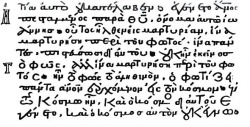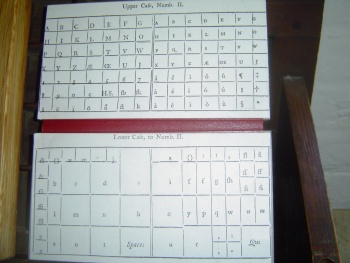Lowercase
From Textus Receptus
(→History) |
|||
| Line 19: | Line 19: | ||
The [[Samaritan alphabet]] also had lower-case letters, making it relatively unusual among [[abjad]]s such as [[Hebrew alphabet|Hebrew]], [[Syriac alphabet|Syriac]] and [[Arabic alphabet|Arabic]], which tend to be written without case. | The [[Samaritan alphabet]] also had lower-case letters, making it relatively unusual among [[abjad]]s such as [[Hebrew alphabet|Hebrew]], [[Syriac alphabet|Syriac]] and [[Arabic alphabet|Arabic]], which tend to be written without case. | ||
| - | [[Image:Evolution of minuscule. | + | [[Image:Evolution of minuscule.png|thumb|none|800px|Simplified relationship between various scripts leading to the development of modern lower case of standard Latin alphabet and that of the modern variants, [[Fraktur (script)|fraktur]] (used in Germany until recently) and [[gaelic script|gaelic]] (Ireland). Several scripts coexisted such as [[half-uncial]] and [[uncial]], which derive from [[Roman cursive]] and [[greek uncial]], and [[Visigothic script|visigothic]], [[Merovingian script|Merovingian (Luxeuil variant here)]] and [[Beneventan script|Beneventan]]. The [[carolingian script|carolingian scrip]] was the basis for [[blackletter]] and [[humanist minuscule]]. What is commonly called "gothic writing" is technically called blackletter (here [[Textualis|Textualis quadrata]]) and is completed unrelated to visigothic script. <br>The letter j is i with a [[flourish]], u and v are the same letter in early scripts and were used depending on their position in insular half-uncial and caroline minuscule and later scripts, w is a ligature of vv, in insular the [[rune]] [[wynn]] is used as a w (three other runes in use were the [[Thorn (letter)|thorn]] (þ), ʻféʼ (ᚠ) as an abbreviation for cattle/goods and maðr (ᛘ) for man). <br>The letters y and z were very rarely used, in particular þ was written identically to y so y was dotted to avoid confusion, the dot was adopted for i only after late-caroline (protgothic), in benevetan script the [[scribal abbreviation|macron abbreviation]] featured a dot above. <br> Lost variants such as [[r rotunda]], ligatures and [[scribal abbreviation|scribal abbreviation marks]] are omitted, [[long s]] is shown when no terminal s (surviving variant) is present. <br>[[Humanist sans-serif|Humanist script]] was the basis for venetian [[Typeface|types]] which changed little until today, such as [[Times Roman|times new roman]] ([[Serif|a serifed typeface]]))]] |
== Usage == | == Usage == | ||
Revision as of 10:43, 4 April 2011
Lower case (also lower-case or lowercase), minuscule, or small letters are the smaller form of letters, as opposed to capital letters, as used in European alphabets (Greek, Latin, Cyrillic, and Armenian). For example, the letter "a" is lower case while the letter "A" is capital. Many users incorrectly equate the term "capital letter" with "upper case" which is incorrect. The term "lower case" evolved after the development of movable type by Johannes Gutenberg. Individual letters were kept in cases on a stand one above the other. The upper case contained capital letters, numbers, capital ligatures and accented characters. The lower case contained the small versions of the letters and their ligatures since these characters were used more frequently.
Originally alphabets were written entirely in capital letters, spaced between well-defined upper and lower bounds. When written quickly with a pen, these tended to turn into rounder and much simpler forms, like uncials. It is from these that the first minuscule hands developed, the half-uncials and cursive minuscule, which no longer stay bound between a pair of lines.[1]
These in turn formed the foundations for the Carolingian minuscule script, developed by Alcuin for use in the court of Charlemagne, which quickly spread across Europe. Here for the first time it became common to mix both upper and lower case letters in a single text.
The term "lower case" comes from manual typesetting. Since minuscules were more frequent in text than majuscules, typesetters placed them in the lower and nearer type case, while the case with the majuscules (the "upper case") was above and behind, a longer reach.
The word minuscule is often spelled miniscule, by association with the unrelated word miniature and the prefix mini-. This has traditionally been regarded as a spelling mistake (since minuscule is derived from the word minus[2]), but is now so common that some dictionaries tend to accept it as a nonstandard or variant spelling.[3] However, miniscule is still less likely to be used for lower-case letters.
Contents |
History

Traditionally, "more important" letters—those beginning sentences or nouns—were made larger; then they were written in a different script, although there was no fixed capitalization system until the early eighteenth century (and even then all nouns were capitalized, a system still followed in German but not in English).
Similar developments have taken place in other alphabets. The lower-case script for the Greek alphabet has its origins in the 7th century and acquired its quadrilinear form in the 8th century. Over time, uncial letter forms were increasingly mixed into the script. The earliest dated Greek lower-case text is the Uspenski Gospels (MS 461) in the year 835. The modern practice of capitalizing every sentence seems to be imported (and is commonly not used when printing Ancient Greek materials even today).
The Samaritan alphabet also had lower-case letters, making it relatively unusual among abjads such as Hebrew, Syriac and Arabic, which tend to be written without case.

The letter j is i with a flourish, u and v are the same letter in early scripts and were used depending on their position in insular half-uncial and caroline minuscule and later scripts, w is a ligature of vv, in insular the rune wynn is used as a w (three other runes in use were the thorn (þ), ʻféʼ (ᚠ) as an abbreviation for cattle/goods and maðr (ᛘ) for man).
The letters y and z were very rarely used, in particular þ was written identically to y so y was dotted to avoid confusion, the dot was adopted for i only after late-caroline (protgothic), in benevetan script the macron abbreviation featured a dot above.
Lost variants such as r rotunda, ligatures and scribal abbreviation marks are omitted, long s is shown when no terminal s (surviving variant) is present.
Humanist script was the basis for venetian types which changed little until today, such as times new roman (a serifed typeface))
Usage
In scripts with a case distinction, the lower case is generally used in most texts, and for most of any given text, with the upper case reserved for emphasis and special contexts.
See also
References
- 1. David Harris. The Calligrapher's Bible. 0764156152
- 2. Charlton T. Lewis, minusculus
- 3. Houghton Mifflin (2000). The American Heritage Dictionary of the English Language (4th ed ed.). Boston and New York: Houghton Mifflin. ISBN 978-0-395-82517-4. http://www.bartleby.com/61/69/M0316900.html.
External links
- Lower Case Definition by The Linux Information Project; also includes information on lower case as it relates to computers.

